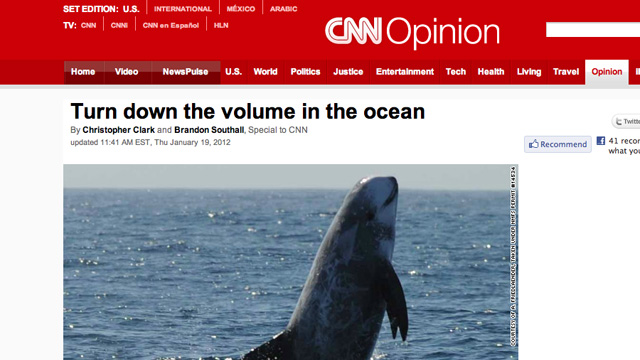FYI – Christopher Clark and I had an opinion piece on CNN today. You can find the permalink at: http://www.cnn.com/2012/01/19/opinion/clark-southall-marine/ and the full text is included below.

Thanks also to our friends at Ocean Conservation Research <see: http://ocr.org/2012/ocean_life/marine-scientists-express-themselves-through-cnn/> and at the New Bedford Whaling Museum <see: http://whalingmuseumblog.org/2012/01/20/the-problem-of-noise-in-the-ocean/> for their informative blogs about this article.
Any comments or perspectives on the suggestions we have put forth in this piece are welcome. Brandon Southall
Turn Down the Volume in the Ocean
Brandon Southall, Special to CNN
For many millions of years, the oceans
have been filled with the sounds of a geologically and biologically active
planet: waves, rain, earthquakes and the songs of life from snapping shrimp to
great whales. Before the age of engine-driven ships, the resounding voices of
the great whales could be heard across an ocean.
Today, in much of the Northern
Hemisphere, commercial shipping clouds the marine acoustic environment with fog
banks of noise, and the near continuous pounding of seismic airguns in search
of fossil fuels beneath the seafloor thunder throughout the waters. In the
ocean’s very quietest moments, blue whales singing off the Grand Banks of
Canada can sometimes be heard more than 1,500 miles away off the coast of
Puerto Rico. But on most days, that distance is a mere 50 to 100 miles.
So why should we care?
Over the past decade, scientists who
study noise in the ocean have tried to understand how loud, man-made sounds
disturb or injure whales and other marine mammals, even driving some to strand
on beaches and die.
It is time for us to focus on the more
pernicious influence of chronic, large-scale noise on marine life.
Whales, dolphins and seals use sounds
to communicate, navigate, find food and detect predators. The rising level of
cumulative noise from energy exploration, offshore development and commercial shipping
is a constant disruption on their social networks. For life in today’s ocean,
the basic activities that we depend on for our lives on land are being eroded
by the increasing amount of human noise beneath the waves.
These stark realities are worrying. But
emerging technologies for quantifying and visualizing the effects of noise
pollution can help drive a paradigm shift in how we perceive, monitor, manage
and mitigate human sounds in the ocean. Ocean noise is a global problem, but
the U.S. should step up and lead the way.
First, we must extend fledgling efforts
to fully comprehend the acoustic footprint of our offshore and coastal
activities. As a nation, we are failing the oceans by lacking a sufficiently
effective program for listening to them.
The U.S. should develop and maintain
dedicated undersea acoustic monitoring networks as integral parts of ocean
observing systems. This would be lead by the National Oceanic and Atmospheric
Administration (NOAA) and enabled through private and academic partnerships.
Such a plan has been developed; now it should be implemented.
Second, we should encourage and
accelerate the development of noise-reduction technologies. Thanks to proactive
collaborations among industries, scientists, environmentalists and government
officials, efforts are underway within the U.N.’s International Maritime
Organization to develop quieting technologies for the most pervasive global
noise source: large commercial ships. These and related technologies for
reducing noise in oil exploration and marine construction should be
standardized.
Finally, federal regulation on ocean
noise must be changed. For decades, regulators have focused entirely on the
short-term effects of one action at a time. A more holistic and biologically
relevant risk assessment system, centered on the concepts of ocean acoustic
habitats and ecosystems, is sorely needed. Emerging trends in marine spatial
planning are encouraging signs, as is NOAA’s support of two groups that are
developing geospatial tools for mapping underwater noise and marine mammal
distributions in U.S. waters.
The loss of acoustic habitats for
marine species that rely on sound to live and prosper is increasing. Solutions
are available. The question is whether we humans value and will invest in a
healthy ocean ecosystem that supports life, and in doing so, sustain our own
health and future.
